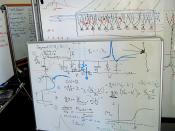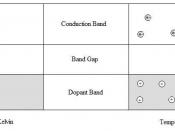Aim:
The aim of this investigation is to investigate and discover if the length of a piece of metal wire effects its resistance when electricity is passed through it.
Prediction
Before I make a prediction I shall explain about atoms, free electrons, electricity and resistance.
Electricity travels through a conductor, in this case a length of wire, by means of free electrons. Electrons are the smallest parts of an atom that is situated in shells (similar to the layers in onions). An atom has protons that are positively charged and neutrons that have a neutral charge (no charge) in the centre. The neutrons and protons are like the core of the atom. There are then electrons that are negatively charged circulating round outside the core (see diagram 1). There are as many electrons as protons in an atom so they cancel each other out and the atom has no overall charge.
In a metal atom's structure on the very outer shell the electrons become free electrons. This means they can move around freely in the solid metal and so the metal can conducts electricity. When a voltage is passed through the metal object the electrons (which are negatively charged) are attracted to the positively charged end of the wire which is towards the positive inlet of the battery or power source (see diagram 2).
This makes all the free electrons line up and move in the same direction (see diagram 3). This is an electrical current.
Resistance is the result of energy lost. It involves collisions between the free electrons and the fixed particles of the atoms in the metal. These collisions lose energy and time and therefore resistance occurs. As the resistance of a material increases so must the force required to push the same amount of current through...


